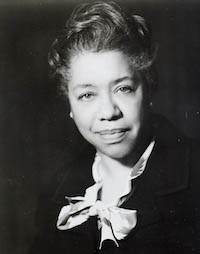Augusta Braxton Baker facts for kids
Quick facts for kids
Augusta Braxton Baker
|
|
|---|---|
 |
|
| Born | April 1, 1911 Baltimore, Maryland, U.S.
|
| Died | February 23, 1998 (aged 86) Columbia, South Carolina, U.S.
|
Augusta Braxton Baker (born April 1, 1911 – died February 23, 1998) was an American librarian and amazing storyteller. She is famous for her important work in children's literature. She especially helped make sure that Black Americans were shown fairly and positively in books for kids.
Growing Up and School
Augusta Braxton Baker was born on April 1, 1911, in Baltimore, Maryland. Both of her parents were schoolteachers. They taught her to love reading from a very young age. While her parents worked, her grandmother, Augusta Fax, took care of her. Her grandmother told her many wonderful stories. Augusta loved these stories so much that she carried this love throughout her life.
She learned to read even before starting elementary school. She then went to a high school where only Black students attended, which was common at that time. Her father taught there. She finished high school at age 16. After that, she went to the University of Pittsburgh. There, she met and married James Baker during her second year.
Augusta and her husband moved to New York. She wanted to transfer to Albany Teacher’s College. However, the college did not want to admit Black students. Eleanor Roosevelt, who was the wife of the New York Governor, Franklin Roosevelt, helped her. Mrs. Roosevelt was on the board of a group that worked for racial fairness. She strongly supported Augusta's transfer. The college didn't want to go against the governor's wife, so Augusta was admitted.
While at college, Augusta realized she didn't want to be a teacher. She said, "I discovered I loved books, but I didn't love teaching." She earned a degree in education in 1933. Then, in 1934, she earned a degree in library science. She became the first African-American person to get a master's degree in librarianship from that college.
Working as a Librarian
After college, Augusta taught for a few years. In 1937, she got a job as a children's librarian. This was at the New York Public Library's 135th Street Branch in Harlem. She applied three times before the head of children's services, Anne Carroll Moore, personally helped her.
In 1939, her library branch started an important project. They wanted to find and collect children's literature that showed Black people in a good way. Before this, many books showed Black people in unfair or stereotypical ways. Augusta started this special collection, called the James Weldon Johnson Memorial Collection of Children's Books. This led to her publishing lists of books for and about Black children. She also encouraged authors, illustrators, and publishers to create more positive books. She also urged libraries to buy these books.
In 1953, Augusta became a Storytelling Specialist. She also became an Assistant Coordinator of Children's Services. Later, in 1961, she became the Coordinator of Children's Services. This made her the first African-American librarian in a leadership role at the New York Public Library (NYPL). In this job, she managed all children's programs across the entire NYPL system. She also set rules for them.
During this time, Augusta was also very active in the American Library Association. She was even president of its Children's Services Division. She also led the committee that chose winners for the famous Newbery Medal and Caldecott Medal. Augusta influenced many children's authors and illustrators. Some of them include Maurice Sendak and Ezra Jack Keats. She also worked as a helper for the new children's TV show Sesame Street.
In 1946, she published a long list of books about the Black experience. It was called Books about Negro Life for Children. She said that books on her list should give "an unbiased, accurate, well rounded picture of Negro life." These lists helped people understand harmful stereotypes in books like The Story of Little Black Sambo.
Augusta retired from the New York Public Library in 1974. But in 1980, she returned to library work. She took a new job as the Storyteller-in-Residence at the University of South Carolina. This was the first job of its kind at any American university. She stayed there until her second retirement in 1994. While there, she co-wrote a book called Storytelling: Art and Technique in 1987.
Her Lasting Impact
Augusta Baker passed away on February 23, 1998, at age 86, after a long illness. Her work and ideas are still important today. One way her legacy continues is through the "Baker’s Dozen: A Celebration of Stories" festival. This annual storytelling event started in 1987. It is still celebrated today by the University of South Carolina and the Richland County Public Library. In 2011, the University also created a special teaching position named after her.
When asked what she told her students, Augusta said: "Let the story tell itself. If it is a good story and you have prepared it well, you do not need all the extras. Children of all ages do want to hear stories. Select well, prepare well, and then go forth, stand tall, and just tell."
Her legacy also lives on through the Augusta Baker Collection of Children's Literature and Folklore. This collection is at the University of South Carolina. Her son donated it. It has over 1,600 children's books. It also includes materials from her own library and papers she used during her career.
Awards and Honors
- First person to receive the E.P. Dutton-John Macrae Award (1953)
- Parents Magazine Medal Award (1966)
- ALA Grolier Award (1968)
- Women's National Book Association, Constance Lindsay Skinner Award (1971)
- Clarence Day Award (1975)
- Honorary ALA Membership (1975)
- Honorary Doctorate from St. John's University (1980)
- Catholic Library Association's Regina Medal (1981)
- Honorary Doctorate from the University of South Carolina (1986)
- Second person to receive the ALSC Distinguished Service Award (1993)

